Hi, friends. I’m writing to you this morning as I eat a giant piece of French bread slathered in Nutella, one of my all-time favorite indulgences.
Before we jump into food, I wanted to give a quick update on things here since I still haven’t nailed a consistent and more frequent writing routine. Work has been really busy, which obviously takes priority (in addition to making it to apéro). Spring in Lyon has been a roller coaster these last 4 weeks, which started with summer-like temps and sunshine but quickly regressed into 3 weeks of unseasonable cold, rain, sleet, some storms, and an overall damper on plans. But, things have been otherwise great and just yesterday we finally returned to “real spring” as I’m calling it, I think for good. We’re still in sweaters mostly, but at least we’ve finally ditched the winter coats. After two reschedules due to floods and terrible weather, we’re looking forward to the upcoming vacation week here in France (Victory in Europe Day is May 8 and Ascension is May 9, so this week is a very common vacation week—I’ve already been warned by our boulanger, patissier, and multiple other people including market vendors that they will be closed all week). We’ll be capping the week off with a kayaking/SUP trip through the Gorges du Tarn, and are SO excited. More details on that soon! Keep reading on to hear all about how we’ve been eating in France.
“What Are We Eating?” is a piece I’ve decided to start in response to a great question from a dear friend—how has living in France changed the way you eat/cook at home? I’ll talk about various topics related to one of my favorite subjects, food! It’s such a complex topic and one I find so fascinating from many angles-health, culture, politics/policy, history…look forward to things like:
The French agricultural system (much more interesting than it sounds)
Food prices in the US vs France
A complete episode on la baguette, a potent little symbol that is more than just a piece of bread
But, for this first edition, I’m answering her question of what we eat and how I cook at home now versus in the US. When I started writing this section, I noted I was snacking on a baguette, pungent goat cheese, and some comté as a little pre-dinner snack, so there’s one glimpse-lots of bread and cheese lol, so cliché, I know.
If several of you are interested, I can put some of the recipes that are my own or available for free online from chefs I like on my Substack so you can have them, too. Let me know in the comments.
If you’ve been forwarding this to someone(s), they can receive these directly by clicking that button below.
Has eating at home changed?
Initially I didn’t think I could say that the way we ate at home had changed much. Many of you know I love food and I love to cook. “Organic” and “local” have been in my food lexicon for years, to varying degrees of success, we’ve always eaten mostly fresh meals at home, and I’m doing the same here. But, after a little more thought, there are some major differences even though I still cook many of the dishes I love and cooked in the US, whether my own, from a favorite cookbook, or borrowed from a friend—lamb tagine with pearl couscous, bolognese, whole roasted chickens and fishes with veggies, and of course, pizza.
Big differences in how we’re eating at home (and out) now versus before.
INGREDIENTS AND PRODUCE
The produce, meats and cheeses we buy here are much fresher than in the US. Not trying to throw daggers, but this is simply a fact. I’ll get into the details more in a different episode, but the proximity and quantity of small farms/farmers who come to the outdoor markets in towns and cities has a lot to do with this (as well as a significant dose of regulations). The produce in grocery stores is also fresher, and mostly French with exceptions for things like tropical fruits, peppers in winter (these are often from Spain) as long as you stay away from the big box chain stores. I go to the outdoor food market at least twice a week, sometimes 3 times. It’s about a 3 minute walk from our apartment, and I get to pick up what is in season and appeals to my whims (I do meal planning in 2-3 day increments now instead of a week). This also means I’ve been wasting less food since I can plan a meal closer to the time when I’m actually going to eat it. It also means we eat at home more often, which is very common in French families. Outdoor markets are all over the city, so most people have easy access to at least one of them.


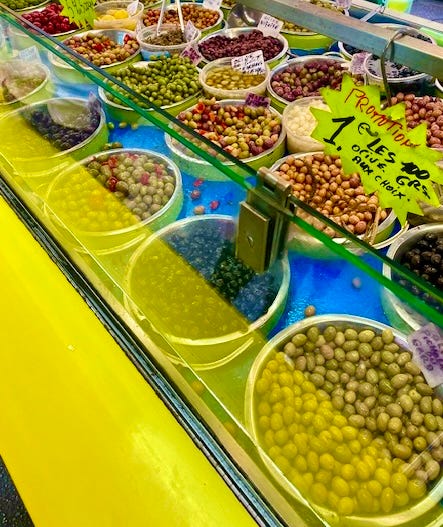
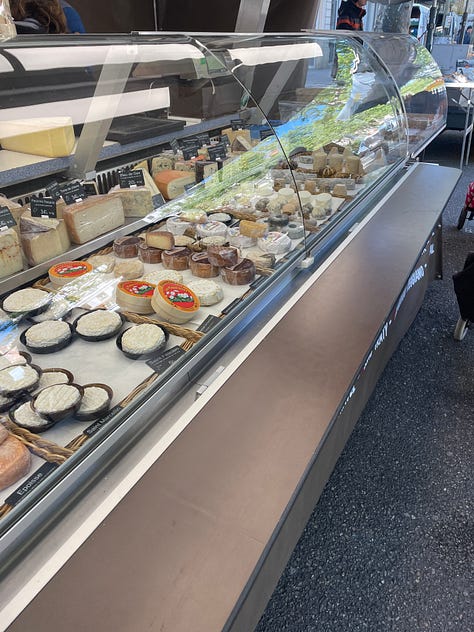
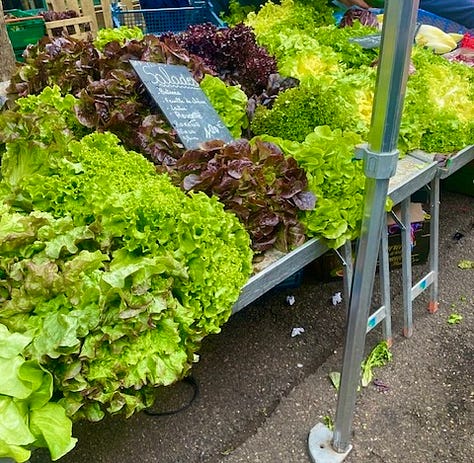
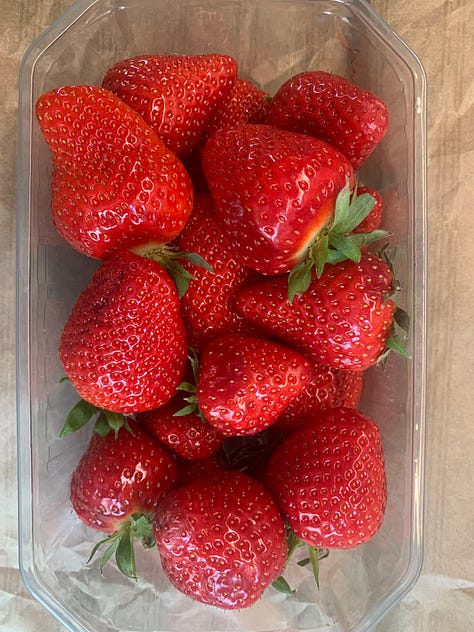
The food here overall has way more color and a healthier appearance than in the US, and I am comparing sometimes organic, but often not, French produce to US organic produce, which we nearly exclusively ate back home. Additionally, produce goes bad pretty fast here, which makes me question what is put on US produce to make it keep for a week or more in the fridge, after its already long journey from farm to store. So while it may be tempting to say that fennel is fennel and flour is flour, the differences in freshness are profound.
MORE SEASONAL EATING
I mean this in the sense of both what’s growing/available, but also what you want to eat due to the weather. Between inherently spending a lot more time outdoors and the buildings here being old and made of stone, you feel the cool weather in winter and the warmth as soon as it heats up. I cooked more soups this winter than I ever have—classics like leek and potato and roasted butternut squash, sausage and white bean, and Allison Roman’s lentil and squash soup that is a new favorite. When it gets hot, I know I’ll be switching to cold fish dishes, gazpachos, and more salads at home. I’ll probably be processing fruits, vegetables, beans and fish a bunch of ways to easily top breads, salads, and cold pastas without using the oven or stove as much as possible. Already we’ve been having a lot of fish salads and marinated anchovies on warmer days, served with a baguette and fruit.
BREAD
We eat bread every. single. day. Usually the baguette, and sometimes 2 of them. And I eat pain au chocolats from the boulangerie at least twice a week. I would have *never* eaten so much bread before, whether on a burger, as a side, or a lunch sandwich due to a few things, including my yeast “allergy” that my allergist thought I had. Revelation: I haven’t had an eczema flare up since I’ve been here, so that’s interesting.

MEATS
I think we eat more meat products than before. We still have some veg only meals each week, but I feel like there’s more meat. We eat terrines and rillettes with bread, France loves burgers, so we absolutely eat more burgers out at restaurants than before. I’ve also eaten some meat dishes on menus here that are still a mystery to me. Most have been things I would eat again, like this andouillette, and some I will certainly not (quenelle). French food is rustic, and they don’t waste parts.
We eat a lot of chicken and fish at home, and beef and pork out at restaurants.
DAIRY, UNPASTEURIZED.
My dairy intake has skyrocketed. We still drink oat milk for coffee and oatmeal, but we eat tons of cheeses from our local market vendors and the cheese store, the fromagerie, sells some amazing local organic yogurt that is now a staple, made right here in the Auvergne-Rhone-Alps region.
Fun fact: cow milk is sold shelf-stable here in France as it’s ultra-high temp sterilized. It’s done this way because drinking milk isn’t something the French do. But, when it comes to any other dairy product that requires fermentation or aging, it is my understanding that NONE of that is pasteurized. Cheese is an art form, and I guess you can’t kill all that moldy goodness in the name of disease prevention : )
DESSERTS AND SWEETS
I’ve always loved desserts and believed that no dinner is complete without a little something sweet, but I also never let myself eat as much of it as I do here. Dessert after lunch or dinner happens pretty much everyday now. These are not giant portions nor are they strongly sweetened. Think fresh, homemade tarte au citron, one of my favorites, or a light profiterole with homemade ice cream and chocolate sauce. These items aren’t that large and are meant to round out the meal, not to be another whole meal. And, the best part is that if you can’t make it to a boulangerie, the grocery store has French desserts like crême brulée, mousse au chocolat, and fondant au chocolat that you can grab and have at home for 2-3 euros.
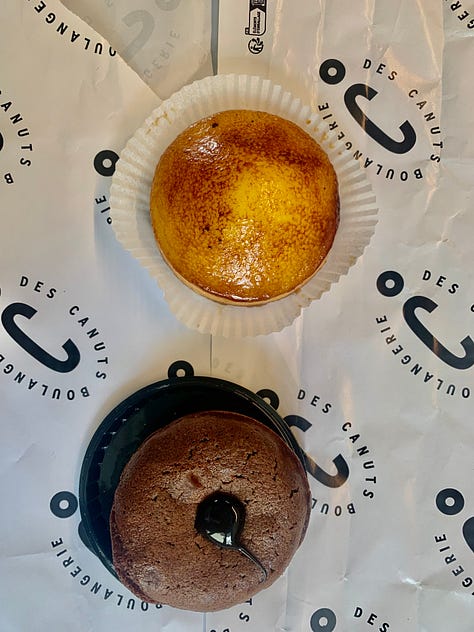
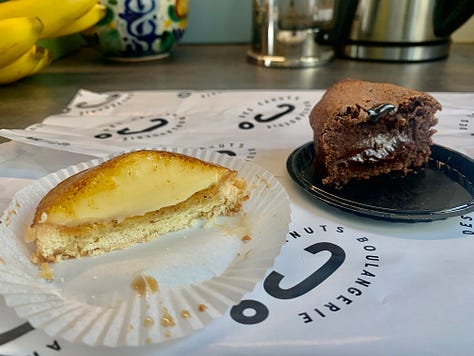
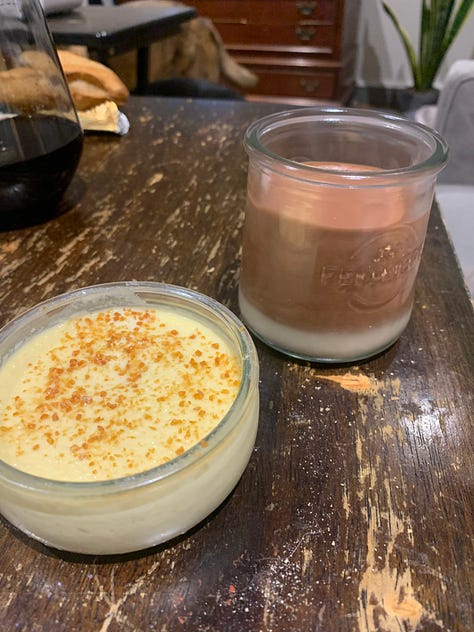
THE FRENCH MENU, also known as the chalkboard menu
This is the best part of eating in France, and the biggest change for us when dining out. Typically taken at lunch, restaurants, cafes, and bars will have a set menu for the meal. These places don’t have fixed menus because they cook what’s available at market, and according to the season. This is very common. It comes in 2-3 courses, and the prices are always excellent value, anywhere from about 18 euros to 25 euros for a 3 course lunch, and they are so fucking good. Typically you can choose between a meat, fish, or veggie main course, and then you have the option of having one or both of an entrée (appetizer) and dessert. Some recent menus I’ve eaten are:
Broccoli and potato soup, roasted chicken and veggies, crème brulée
Oysters, white fish with veggies, profiterole
Terrine brioché, steak and veggies, tiramisu
I will also stress that French dishes often have a lot of vegetables built into the dish. Even burgers and burritos are almost exclusively served with a large green salad, not fries (which you can add if you want, but you’ll still get a salad). I’ve really come to love getting a huge salad with my burrito, as weird as that sounds.

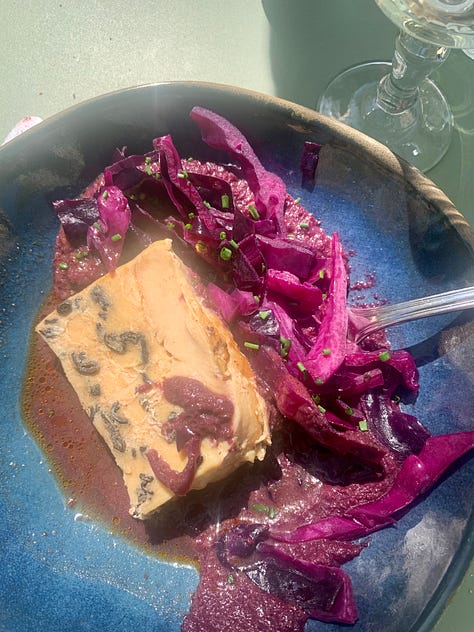
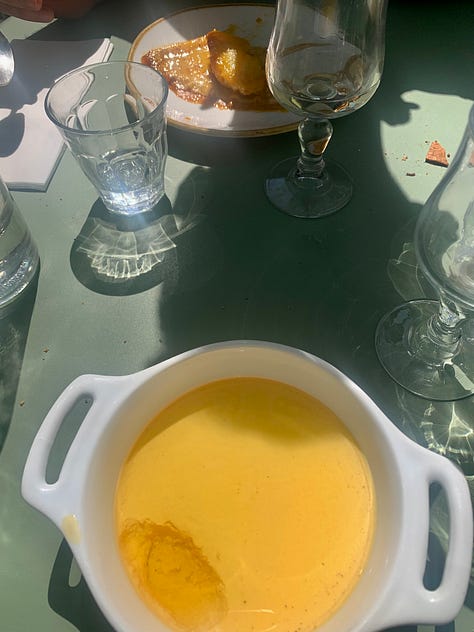
DRINKING LESS?
This is questionable in terms of volume, because wine and beer flow much faster than water here, but liquor-based drinks are nowhere near as common as in the US. Of course you can find them, and we certainly drink them out and make them at home still, but it’s less than in the States. Delicious, quality bottles of wine are available at grocery stores for 5 euros, and bars often have local wines for 3-6 euros a glass. Pints of local IPAs are 5 euros on happy hours, which usually run until 8pm or later. So it’s easy to default away from a couple of really boozy cocktails and towards those two glasses of local wine. And we know not all alcoholic drinks are created equal in terms of overall alcohol content, so I do think alcohol consumption is lower by concentration.
Feel free to sound off in the comments with any French/US food thoughts, questions or comments!




So, the French don't normally offer "French" fries with their burgers. That's funny. Of course, I'm not sure there is really anything all that French about the fries we get here in the US.
This made me hungry :D. So interesting that your produce goes bad faster than it did in the U.S.... totally different industry and model, I guess. Love reading about the chalkboard menu... sometimes less choice is better!